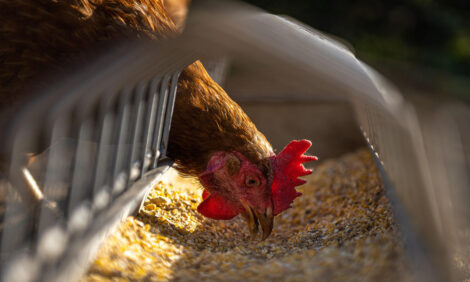



Parasite Management for Natural and Organic Poultry: Blackhead in Turkeys - Part 1
Covered in this, the first part of a two-part series, are a history of blackhead (histomoniasis) in the US, the life cycle of the pathogen, transmission of infection and diagnosis of the disease. By Terrell Spencer, agriculture specialist with National Center for Appropriate Technology (NCAT) and published by the US National Sustainable Agriculture Information Service, ATTRA.Blackhead disease, also called histomoniasis, is a serious disease capable of decimating turkey flocks and negatively affecting other poultry. Caused by the protozoan Histomonas meleagridis, Blackhead can also have a significant economic impact on chicken production. Recent research has revealed new information about the bird-to-bird transmission of blackhead through a previously unknown pathway – cloacal drinking. This publication addresses the new research as well as focusing on the history, life cycle, diagnosis, prevention, and management of blackhead disease, primarily in turkeys. The effect Histomoniasis has on other poultry species (chickens, gamebirds, and peafowl) is also discussed briefly.
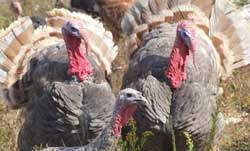
History of Blackhead in the United States
The first reported case of blackhead disease in the United States occurred in Rhode Island in 1893, possibly carried to the US by pheasants imported the decade before. Blackhead then spread throughout the US, ravaging turkey flocks in New England and following production like a faithful shadow. Outbreaks of blackhead rapidly spread down the Eastern Seaboard, into the Midwest and the far western United States. Despite the growing demands of an expanding population, turkey production dropped from 11 million birds in 1890, just years before the first blackhead outbreak, to an average of 3.7 million turkeys per year during the 1910–1920 decade.
The development of antihistomonal drugs in the 1960s led to a dramatic decrease in blackhead-related turkey deaths. Unfortunately for poultry producers, the drugs developed to treat Histomoniasis were eventually banned (McDougald, 2005). As more farmers enter into free-range and pastured-poultry systems, often combining multiple poultry species on the same land, blackhead outbreaks may be of increasing concern and economic impact.
The Life Cycle and Infectious Pathway of Blackhead
Blackhead occurs when the causal agent, the protozoan Histomonas meleagridis, gains access to the caeca, or blind pouches of the intestines. Blackhead infects poultry using three separate pathways that will be examined in detail in this publication:
- Ingestion of soil or earthworms containing eggs of the caecal worm Heterakis gallinarum, infected with H. meleagridis
- Uptake of H. meleagridis directly into the lower digestive tract through the process of 'cloacal drinking'
- Oral ingestion of live H. meleagridis protozoa when stomach is not acidic enough to kill the pathogen.
* "Cloacal drinking is the reflexive intake of fluids through the cloaca in order to inoculate the young bird’s immune system with the microbial fl ora of the surrounding environment." |
Once access into the digestive tract has been achieved, H. meleagridis multiplies in the caeca and attacks the tissues of the caecal walls. As the disease progresses, a cheese-like, foul-smelling, yellow substance fills the caeca. This substance can vary in form from a hardened plug to more liquid in nature, and is composed of dead caecal cells and blood. In highly susceptible birds such as turkeys, the blackhead protozoa then enter the bloodstream through the damaged caeca and are deposited into the liver, where they do even more damage, creating signature 'bulls-eye' zones of necrosis (dead tissue). Occasionally, H. meleagridis also enters into other organs such as the kidneys, lungs, heart and brain.
Blackhead does not kill the infected bird, and the disease requires a secondary bacterial infection to be virulent and eventually fatal. Escherichia coli, Bacillus subtilis, and Clostridium sp. are some of the bacteria noted in the secondary infections that caused death (McDougald, 2005).
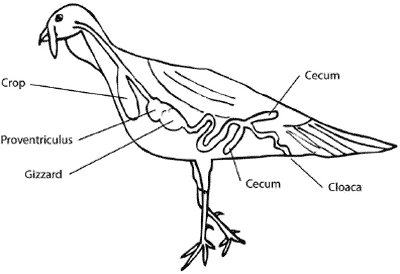
By Terrell Spencer, NCAT
Poultry Species as Blackhead Reservoirs
Among poultry species, there are varying degrees of susceptibility to blackhead. Some birds, such as pheasants, ducks, and geese, are nearly immune to the effects of blackhead. Chickens are somewhat resistant to the disease, while turkeys and peafowl are extremely vulnerable and have high mortality rates when infected with H. meleagridis. Experiments have shown that infected pheasants and chickens are capable of transmitting blackhead to young turkeys (Lund and Chute, 1972).
Traditional wisdom dictating that chickens and turkeys not be raised together is most likely based on experience with Histomoniasis. Chickens are excellent hosts for the caecal worm that H. meleagridis uses as a vector. It is not unreasonable to assume that the majority of blackhead outbreaks, especially among small, diversified farmers, can be traced back to chickens.
Among chickens, laying hens and breeding roosters have the potential to shed many more caecal worm eggs than broilers due to age differences in production – a broiler is usually slaughtered at six to 12 weeks (six to eight weeks for Cornish cross; 12+ weeks for slower-growing breeds), while a hen may be kept for two or more years. The caecal worm in question, H. gallinarum, takes approximately a month to mature and begin shedding eggs. This time frame, coupled with the two to four weeks chicks spend in the brooder, allows little to no time for a broiler to contaminate the soil with caecal worm eggs. On the other hand, a hen in production for several years can seed tremendous amounts of caecal worm eggs into the soil during her lifetime.
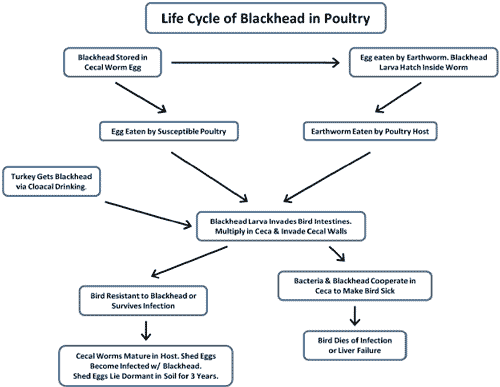
By Terrell Spencer, NCAT
Blackhead Transmission through Caecal Worm Eggs and Soil
The indirect ingestion of blackhead protozoa through consumption of earthworms and caecal worm eggs is the most commonly known means of contracting histomoniasis. When exposed to the elements, the blackhead pathogen is short-lived, being highly susceptible to environmental stresses—sunlight, wind, and temperature extremes. H. meleagridis has overcome this limitation through infecting caecal worm eggs, as these eggs are extremely hardy.
The eggs can remain viable up to three years in the soil; in addition, caecal worms are very common in many poultry species, especially chickens. Contaminated caecal worm eggs are consumed when birds ingest soil either intentionally or during foraging. Earthworms also act as an intermediate vehicle for spreading the disease, as the earthworms consume soil containing the infected caecal worm eggs. The earthworms, in turn, are readily consumed by all types of poultry.
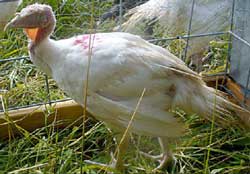
Photo by Terrell Spencer, NCAT
Horizontal Spreading of Blackhead through Turkey Flocks
The contraction of blackhead disease by turkeys has traditionally been attributed solely to the vectoring of the disease through caecal worm eggs and earthworms. However, recent research has shown that turkeys can infect other members of the flock directly through a process known as cloacal drinking (Hu et al., 2004, McDougald and Fuller, 2005).
Unfortunately for both the turkey and the farmer, the turkey immune system has little to no defence against blackhead, and the blackhead protozoans that enter through the cloaca multiply unrestricted. Uptake of H. meleagridis through the cloaca occurs when a turkey's cloaca comes into contact with contaminated faecal matter, most likely while resting. The pathogenic protozoa are then drawn into the digestive tract through the cloacal drinking process and migrate to the caeca, where infection occurs.
Historically, contraction of blackhead through caecal worm eggs has explained the beginning of outbreaks in poultry flocks but failed to account for the rapidity with which blackhead spreads throughout the flock. The lack of an explanation for the continued transmission of histomoniasis through a flock, despite the exclusion of earthworms and soil containing caecal worm eggs, has been a source of frustration and setback for farmers. Now, thanks to recent research findings, this gap in the basic understanding of the blackhead lifecycle has been closed.

Photo by Terrell Spencer, NCAT
Oral Ingestion and Contraction of Blackhead
When the turkey is given a constant supply of food, experiments have suggested that H. meleagridis ingested orally is not capable of surviving the passage through the stomach—more specifically, the proventriculus – due to the stomach acids produced. Therefore, blackhead is typically not transmitted orally (Hu et al., 2004). When a turkey feeds, acid is produced to aid in digestion, and this acidification destroys H. meleagridis. After six hours of not feeding, however, the lack of stomach acid allows the turkey's gastrointestinal tract to go from being acidic to neutral in pH, and this change can allow H. meleagridis to survive oral ingestion (McDougald, 2010).
Diagnosis and Symptoms of Infected Turkeys
Physical symptoms of blackhead
- Mustardy, yellowish coloured stool— varies from a watery, foamy diarrhea to a dry, solid black stool with waxy yellowish streaks
- Bulls-eye-shaped necrotic pitting on liver
- Caeca filled with yellow, cheesy substance
Behavioural signs of blackhead
- Lethargy
- Drooping wings
- Dry, ruffled feathers
- Suppressed appetite, increased thirst
- Decreased/lack of flight distance (distance the turkey keeps between itself and humans)
- Decreased/lack of inquisitiveness

below: Enlarged caecum filled with yellowish necrotic tissue in a blackhead-infected turkey
Photos by Terrell Spencer, NCAT
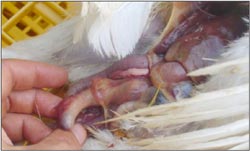
Blackhead infections vary in the time required to manifest signs, depending on the pathway and initial amount of infection. Signs of infection begin to appear seven to 14 days after exposure. In turkeys, the yellow-coloured faecal matter is the definitive symptom of blackhead disease. From personal experience, when behavioural symptoms become apparent, mortality usually occurs in one to three days. Positive diagnosis of dead birds can be easily obtained through a post-mortem dissection (necropsy) by the farmer. The abdominal cavity can be opened and the caecum examined. The chest/breast can then be split down the middle using heavy duty shears or tin snips to reveal the liver. Once the caeca and liver are exposed, the organs can be inspected for necrosis as described above.
Despite the descriptive name of the disease, blackhead rarely, if ever, causes the head of the infected bird to darken or turn black, so the common name is somewhat of a misnomer (Davidson and Doster, 2010).
Turkeys demonstrate the most severe symptoms of any poultry from H. meleagridis infection and, consequently, the highest mortality rates. Indeed, expectations of 80 to 100 per cent mortality are plausible in turkey blackhead outbreaks. Chickens are usually able to stop the disease before destruction of the caeca and degradation of the liver take place. Infections in chickens often are undiagnosed, though in chickens the impact of blackhead has been described as being at least as severe as coccidiosis, and in some broiler breeder flocks, mortality may reach as high as 10 per cent (McDougald, 2005). Bobwhite quail farmers have also occasionally experienced outbreaks of blackhead disease, especially when these growers utilise old chicken houses.
The second part of this publication will follow next week.
Further Reading
| - | Find out more information on blackhead by clicking here. |
November 2010








